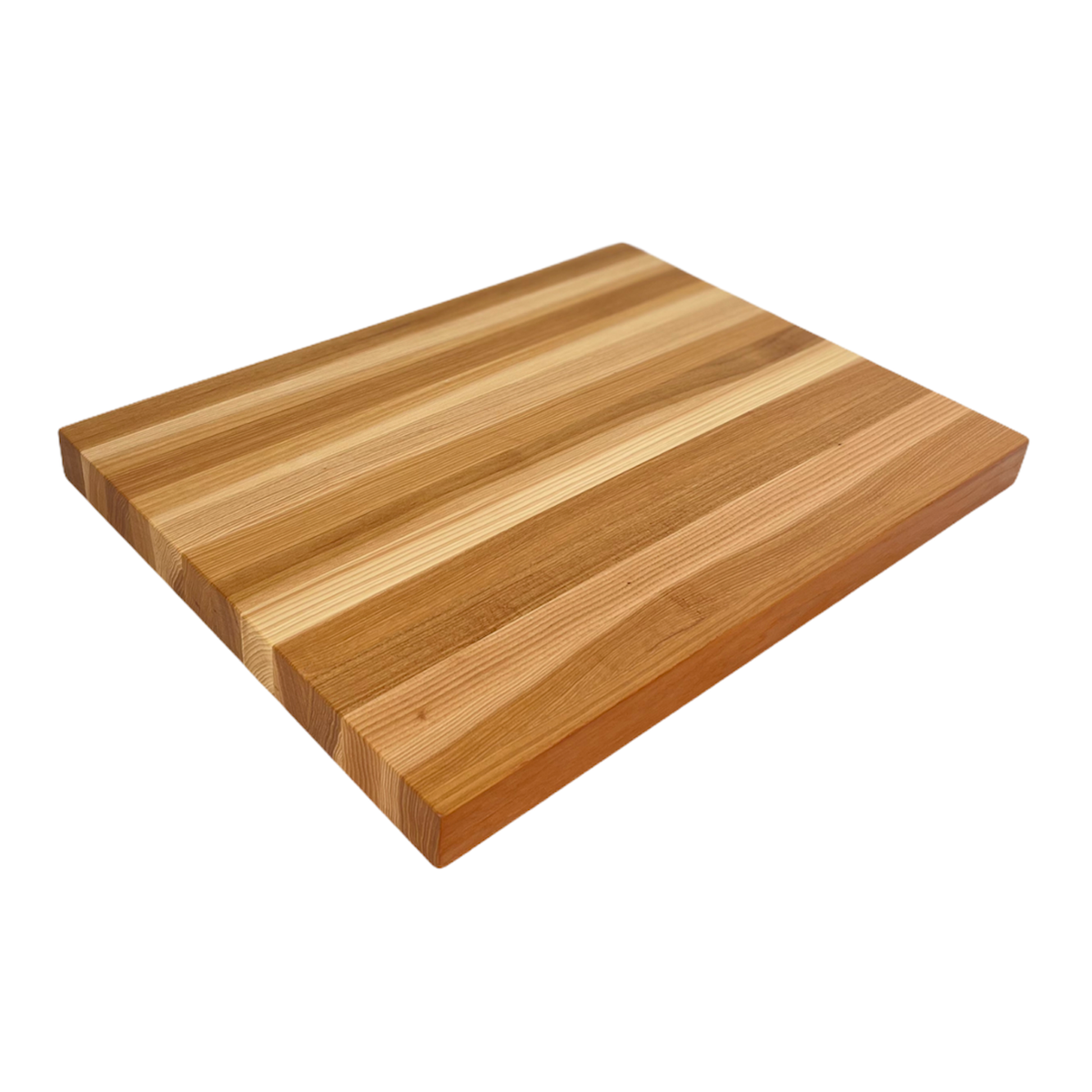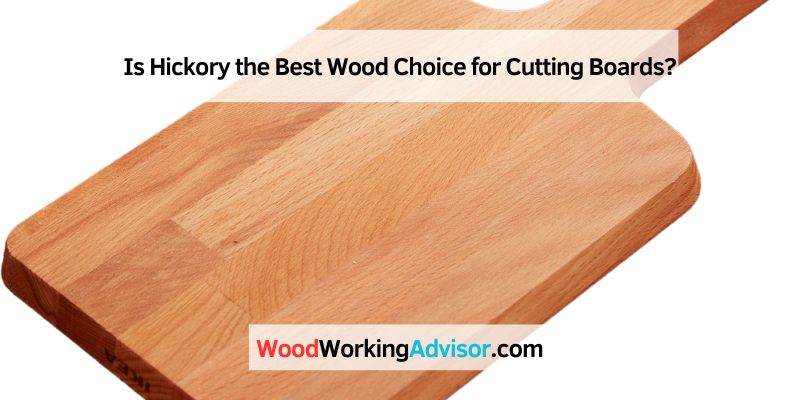Yes, hickory is an excellent wood for cutting boards due to its hardness and durability. With its natural resistance to moisture and bacteria, hickory makes a reliable choice for kitchen surfaces, ensuring longevity and ease of maintenance.
Using a hickory cutting board provides a sturdy and reliable surface for chopping, slicing, and dicing ingredients without damaging the board or dulling the knife. Additionally, the beautiful natural grain pattern of hickory adds an aesthetic appeal to any kitchen decor.
Whether you are a home cook or a professional chef, investing in a hickory cutting board is a wise choice for a reliable and long-lasting kitchen tool.

Credit: www.armanifinewoodworking.com
The Benefits Of Hickory Wood
Hickory wood is a popular choice for cutting boards due to its numerous benefits. As a highly durable and long-lasting material, hickory provides a reliable surface for all your cutting and chopping needs. Its natural resistance to moisture and mold further enhances its desirability in the kitchen. In this article, we will explore the advantages of hickory wood for cutting boards, focusing on its durability and resistance to moisture and mold.
Hickory wood is renowned for its exceptional durability, making it an ideal choice for cutting boards. With a Janka hardness rating of 1820, hickory is one of the hardest domestic hardwoods available. This means that your hickory cutting board is less likely to warp, crack, or dent, even after years of heavy use. Its inherent strength allows it to withstand the pressures of daily food preparation, ensuring that it remains reliable and functional for a long time.
Moreover, hickory wood has a tight grain structure, which adds to its durability. The tight grain minimizes the risk of splintering, ensuring a smooth surface for cutting, slicing, and dicing. This quality is particularly important when using sharp knives, as a splinter-free surface reduces the chances of accidents or damage to your knives.
Moisture and mold are common concerns in the kitchen, particularly when it comes to cutting boards. However, hickory wood possesses natural properties that make it highly resistant to both moisture and mold growth.
The moisture resistance of hickory wood arises from its dense and closed grain structure. This structure minimizes the absorption of water and liquids, preventing them from seeping into the board and potentially causing warping, splitting, or cracking. As a result, your hickory cutting board will maintain its integrity and shape, even in high humidity environments.
In addition to moisture resistance, hickory wood exhibits natural antimicrobial properties that inhibit the growth of mold and bacteria. This is a crucial advantage for a cutting board, as it helps maintain a hygienic and safe food preparation surface. With a hickory cutting board, you can confidently chop vegetables, slice meats, and handle other food items without worrying about mold or bacteria contamination.
In conclusion, hickory wood offers significant benefits for cutting boards. Its durability, long-lasting nature, and resistance to moisture and mold make it an excellent choice for any kitchen. With a hickory cutting board, you can enjoy a reliable, splinter-free surface that withstands years of use while providing a safe and hygienic environment for food preparation.
Considerations For Cutting Boards
When it comes to choosing the perfect cutting board, there are several important considerations to keep in mind. One of the key factors to consider is the type of wood used for the cutting board. Hickory is a popular choice for cutting boards due to its inherent hardwood qualities. In this article, we will explore the considerations for cutting boards, focusing on the hardness and strength of hickory, as well as its maintenance and care.
Hardness And Strength
Hickory is well-known for its exceptional hardness and strength, making it an ideal choice for cutting boards. It is one of the hardest domestic hardwoods available, ranking highly on the Janka hardness scale. The Janka hardness scale measures the resistance of a wood species to wear and denting, with higher values indicating greater hardness.
With a Janka hardness rating of approximately 1820 pounds, hickory surpasses other popular wood options such as oak and maple. The hardness and strength of hickory make it highly resistant to knife marks and deep grooves, ensuring the durability and longevity of the cutting board.
Maintenance And Care
Proper maintenance and care are crucial to ensure the longevity and functionality of any cutting board, including hickory cutting boards. While hickory is naturally resistant to moisture and bacteria, it is essential to follow a few simple maintenance and care guidelines.
- Regular cleaning: Clean the hickory cutting board with warm soapy water after each use. Use a soft cloth or sponge to thoroughly clean both sides of the board.
- Drying: After cleaning, ensure the cutting board is completely dry before storing it. Excess moisture can lead to warping and cracking.
- Oil application: To maintain the natural beauty and prolong the lifespan of the hickory cutting board, apply food-safe mineral oil once a month. The oil helps to seal the wood and prevent it from drying out.
- Avoid harsh detergents and chemicals: Harsh detergents and chemicals can damage the wood and strip away the natural oils. Stick to mild dish soap and avoid bleach or ammonia-based cleaners.
- Avoid excessive heat and soaking: Do not expose the hickory cutting board to excessive heat or soak it in water for extended periods. Extreme temperature changes and prolonged exposure to water can cause the wood to warp or crack.
By following these simple maintenance and care practices, you can ensure that your hickory cutting board remains in optimal condition for years to come. The hardness and strength of hickory, combined with proper maintenance, make it an excellent choice for a reliable and long-lasting cutting board.
Alternative Wood Choices
When it comes to cutting boards, hickory is a popular choice due to its durability and attractive natural grain. However, there are several alternative wood choices that are also excellent for cutting boards. Each type of wood offers its own unique qualities and benefits.
Maple Wood
Maple wood is a popular choice for cutting boards due to its natural strength and durability. The tight grain of maple wood makes it resistant to cuts and scratches, while its light color and smooth texture add a touch of elegance to any kitchen. Additionally, maple has natural antimicrobial properties, making it a hygienic option for food preparation.
Walnut Wood
Walnut wood is prized for its rich, dark color and distinctive grain patterns, making it a stylish choice for cutting boards. In addition to its visual appeal, walnut wood is known for its hardness and resistance to moisture, making it a durable and long-lasting option. The natural oils in walnut wood also help to repel bacteria and odors, further enhancing its suitability for use in the kitchen.

Credit: hardwood-lumber.com
Expert Tips For Choosing Wood Cutting Boards
Hickory wood cutting boards offer durability and natural antimicrobial properties, making them a great choice for food preparation. With their beautiful grain patterns and resistance to warping, hickory cutting boards are a reliable and long-lasting option for home cooks and professional chefs alike.
When it comes to choosing a wood cutting board, there are a few things to consider to ensure you are getting the best quality and longevity for your kitchen. Below are expert tips to help you make an informed decision.
Matching Wood Type To Use
Every wood type has unique characteristics that can impact its durability and performance as a cutting board.
Here are some popular wood types commonly used for cutting boards:
| Wood Type | Characteristics |
|---|---|
| Maple | The most popular choice for cutting boards. It is hard, durable, and has natural antimicrobial properties. |
| Walnut | Aesthetically pleasing and has a rich, dark color. It is also durable and resistant to knife marks. |
| Cherry | Beautiful reddish hue and has natural antimicrobial properties. It is slightly softer than maple. |
When choosing a wood type, consider the hardness, durability, and maintenance requirements that align with your preferences and cooking habits.
Sustainability And Sourcing
Sustainability is an important factor to consider when selecting a wood-cutting board. Opting for responsibly sourced wood helps protect the environment and supports sustainable forestry practices. Look for certifications like the Forest Stewardship Council (FSC) or the Sustainable Forestry Initiative (SFI) to ensure the wood comes from well-managed forests.
Additionally, consider the local sourcing of the wood. Choosing locally sourced wood reduces carbon emissions associated with transportation and supports local businesses.
By following these expert tips for choosing wood cutting boards, you can make an informed decision that meets your needs while being environmentally conscious.
- Consider the wood type’s hardness, durability, and maintenance requirements.
- Maple, walnut, and cherry are popular choices with unique characteristics.
- Look for certifications like FSC or SFI for sustainable and responsibly sourced wood.
- Opt for locally sourced wood to minimize carbon emissions and support local businesses.

Credit: www.wayfair.com
Frequently Asked Questions Of Is Hickory Good For Cutting Boards
Can I Use Hickory For Cutting Board?
Yes, Hickory can be used for cutting boards due to its durability and resistance to wear. It is a popular choice for kitchen utensils.
What Wood Should Not Be Used For Cutting Boards?
Avoid using softwoods such as pine or cedar for cutting boards as they are prone to scratches, stains, and bacterial growth. Hardwoods like maple, walnut, and cherry are better choices due to their durability, natural antimicrobial properties, and resistance to knife marks.
What Type Of Wood Cutting Board Is Best?
A hardwood cutting board is best as it’s durable, resistant to bacteria, and gentle on knife blades. Maple, walnut, and cherry are popular choices. These boards require regular maintenance with mineral oil to keep them looking good and extend their lifespan.
Avoid using bamboo or plastic cutting boards.
What Type Of Material Is Not Recommended For Cutting Boards Why?
Avoid glass and metal cutting boards as they can dull knives and cause damage. These materials are not suitable for cutting boards as they can also pose a risk of chipping, which can contaminate food. Stick to wood, bamboo, or plastic for safe and effective cutting surfaces.
Conclusion
Hickory is an excellent choice for cutting boards due to its durability and natural antibacterial properties. Its beautiful grain patterns add a touch of elegance to any kitchen. When properly maintained, hickory cutting boards can last for years, making them a sustainable and practical option for food preparation.


